Tuesday, September 20, 2005
Dr. Goodheart goes Hollywood
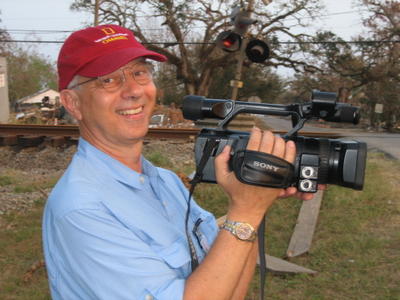 Do we have to change the name of the blog to Dr. Swellhead?
Do we have to change the name of the blog to Dr. Swellhead?Thanks to links to Dr. Goodheart by Powerline, Mudville Gazette, Hugh Hewitt and others, someone in Towers Productions in Chicago, a company that makes documentaries for the National Geographic channel (they made the highly regarded “Inside 9/11”), saw my blog. They are in the process of making a 2-hour documentary covering Hurricane Katrina and the disaster relief response. I guess they liked the ground-level view of what’s going on in the Biloxi area, so they asked if I could meet with their crew.
We arranged to meet on Sunday. Sarah Huisenga, Ralph Madison and Keith Francis arrived from Mobile in Ralph’s big Ford van, loaded with videography equipment and organic food. The first thing I learned was that Keith and Ralph are now homeless, their homes in New Orleans having been flooded by Katrina. The second thing I learned is that--organic trail mix notwithstanding--these are good folks with lots of empathy for the victims of Katrina and a determination to tell their stories.
 They’ve been interviewing people like General Honoré as well as getting video of the flooded areas in New Orleans, but had not yet seen the hardest hit areas of Mississippi.
They’ve been interviewing people like General Honoré as well as getting video of the flooded areas in New Orleans, but had not yet seen the hardest hit areas of Mississippi. Sarah, the producer, and I talked about where we might go and which of the stories I had written about might be good for the documentary. We decided to go back to the school in the rural community of DeDeaux. It’s been about a week since I was last there.
We found the school still a beehive of activity. Supplies are being delivered and distributed; the Salvation Army is distributing hot meals from their truck; and a different team of physicians had already come and gone. Medications and medical supplies were now being kept in the school building, which is now air-conditioned (hooray!). Three people are now keeping the medical aid station going: Keith Hunter, Jeremy Alford, and Alanna Edwards. They have brought in substantial new supplies, and Keith is making trips to Walgreens to fill the local folks’ prescriptions; Walgreens is charging it to FEMA. Keith and Jeremy are scouting the surrounding communities for shut-ins and others in need.
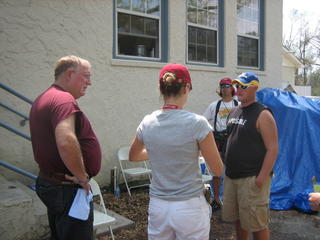 Ken Barber (in the red T-shirt, left) is the local gentleman (he married a woman from Dedeaux 30 years ago) who is now heading up the community effort. The National Geographic crew interviewed Ken; then spoke with Dennis, a man who owns a small business in Connecticut who closed up shop and brought a pickup, trailer, and tools down here
Ken Barber (in the red T-shirt, left) is the local gentleman (he married a woman from Dedeaux 30 years ago) who is now heading up the community effort. The National Geographic crew interviewed Ken; then spoke with Dennis, a man who owns a small business in Connecticut who closed up shop and brought a pickup, trailer, and tools down hereon his own.
 Dennis has gone from community to community, trying to identify needs and get supply distribution started. Once started, he then moves on to another community. Dennis, like many of the folks who have come down here, is a little hyper, but that seems to be what separates the people who wanted to come from the people who actually did.
Dennis has gone from community to community, trying to identify needs and get supply distribution started. Once started, he then moves on to another community. Dennis, like many of the folks who have come down here, is a little hyper, but that seems to be what separates the people who wanted to come from the people who actually did.  We managed to scrounge up some patients who needed to see a doctor so they could video my taking care of them and pretend that I spent all my time doing this instead of traveling around with a video crew.
We managed to scrounge up some patients who needed to see a doctor so they could video my taking care of them and pretend that I spent all my time doing this instead of traveling around with a video crew.Left is Branlyn with her puppy.

Right: Two Sarahs.
Since we were close to two of the coastal communities that had been hardest hit, Bay St. Louis and Waveland, we drove toward the beach so they could video the damage there. On the way down, I could tell from their excited reactions--to the trees blown over and the houses that were wind-damaged—that they hadn’t yet seen the real picture of Katrina’s devastation.
As we got closer to the shore—but still several miles away—we stopped to video an area where a bunch of cars were strewn beside the road, apparently swept there by the storm surge from a used car lot.
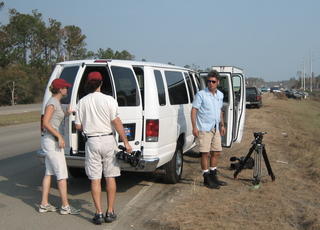 The crew has three high-definition video cameras. The big Sony is used by Ralph for the primary video; the others are for back-up and for documenting the process—the “Making of the National Geographic Katrina Special Documentary” video. Below, right, is Ralph shooting the video, Sarah doing back-up, and Keith doing the “Making of…”video. So this is a photo of the video of the video. Whoa….
The crew has three high-definition video cameras. The big Sony is used by Ralph for the primary video; the others are for back-up and for documenting the process—the “Making of the National Geographic Katrina Special Documentary” video. Below, right, is Ralph shooting the video, Sarah doing back-up, and Keith doing the “Making of…”video. So this is a photo of the video of the video. Whoa….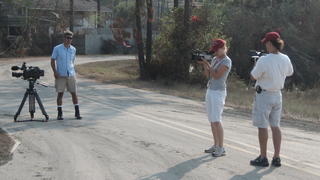
As we drive closer to the shore, the damage gets worse; but then we come to the railroad tracks, the bed of which is on a berm above ground level, so that they served as a barrier to the storm surge.
The tracks here are twisted (one is reminded of what Sherman did to the southern railroads, heating the rails and twisting them around trees to make “Sherman’s hairpins”) and the bed eroded.
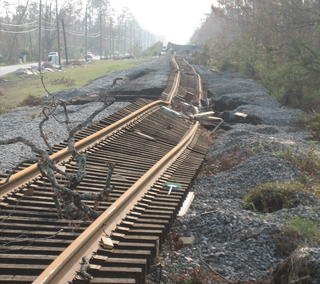 Throughout the Mississippi Gulf coast, “south of the railroad tracks” is where the devastation is worst. Here in what was Waveland, barely a house is left standing for miles. We drove along the shoreline road, and our hard-bitten journalists were struck dumb by the miles of rubble that used to be Waveland.
Throughout the Mississippi Gulf coast, “south of the railroad tracks” is where the devastation is worst. Here in what was Waveland, barely a house is left standing for miles. We drove along the shoreline road, and our hard-bitten journalists were struck dumb by the miles of rubble that used to be Waveland.Arriving at St. Stanislaus College in Bay St. Louis, we found a dormitory that—after Hurricane Camille—had been built to take 300 mile per hour winds; the ground floor is a parking garage, the dormitory rooms on the second floor, on concrete pylons. A man familiar with what happened at St. Stanislaus during the storm told us that about 50 students—mostly international students who had no homes to go to—and the brothers on the faculty rode out the storm right there in the dorm rooms. They could hear cars in the garage below being battered into the concrete pylons beneath them. Of all the hundreds of buildings that had been standing along miles of beach, only this one survived intact.
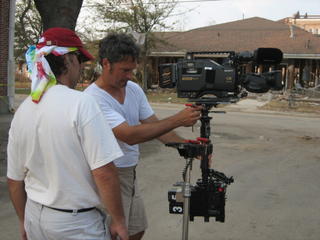 The video crew decided that the best way to try to convey the enormity of the devastation would be to have a single continuous Steadi-Cam shot out of the side of the van while we drove along several miles; then to show that in time-lapse mode.
The video crew decided that the best way to try to convey the enormity of the devastation would be to have a single continuous Steadi-Cam shot out of the side of the van while we drove along several miles; then to show that in time-lapse mode. I had never seen a Steadi-Cam before; it is a remarkable contraption; it has no active gyroscopic stabilization, only a counterbalance mechanism and pivoting mechanisms that keep the camera steady while the operator walks, runs, drives, etc. Think of a show like “Cops” in which a cameraman follows the police chasing a ‘perp’. Without the Steadi-Cam, we’d all get seasick watching it.
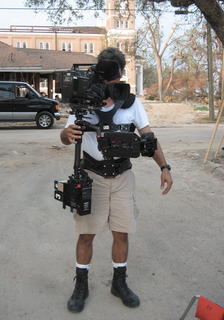
Ralph demonstrates the effectiveness of the Steadi-Cam by jumping up and down (the rig weighs 60 pounds with the camera!) while the camera remains immobile. We tie open the doors of the van; Ralph sits in the open doorway with Keith holding him; Sarah drives; and Dr. Goodheart, videographer, gets to use the HD video camera to document the whole thing.
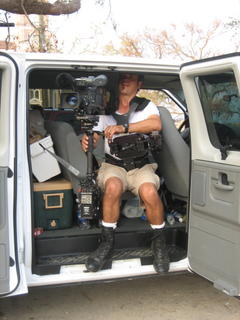 I have high hopes for this National Geographic documentary, because I found Sarah and her crew to be immensely sympathetic to the people we talked to, and as awestruck as I at the incomprehensible scale of the devastation wrought by Katrina. Please keep an eye out for it on the National Geographic channel in about seven weeks. You still have time to run out, buy a 50-inch HD LCD TV, and get the premium cable package that includes the high-def National Geo channel.
I have high hopes for this National Geographic documentary, because I found Sarah and her crew to be immensely sympathetic to the people we talked to, and as awestruck as I at the incomprehensible scale of the devastation wrought by Katrina. Please keep an eye out for it on the National Geographic channel in about seven weeks. You still have time to run out, buy a 50-inch HD LCD TV, and get the premium cable package that includes the high-def National Geo channel.Full disclosure: Keith wanted to make a contribution to the effort, and the next day brought back the dark chocolate I requested for myself, and three fresh pies for the nursing staff at Biloxi Regional.
